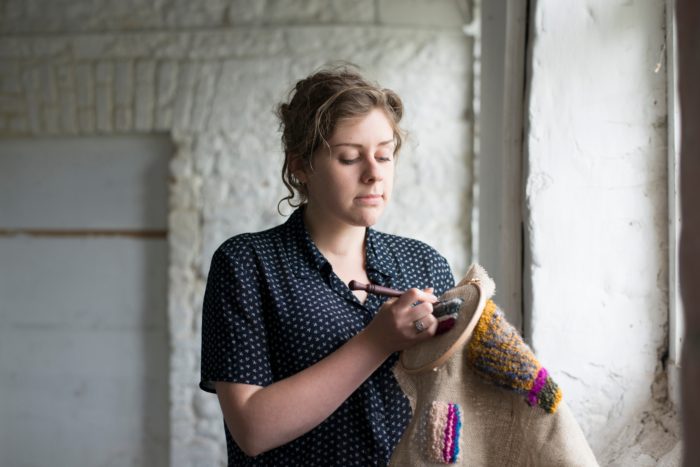Exhibition text for Holding Place: Close for Comfort. By Jane Walker
Close for Comfort
Holding Place, an exhibition at Eastern Edge fills the gallery with imagery of urban and rural Newfoundland. Artists Christeen Francis, Emily Neufeld, and Andrew Testa each respond to their relationship with these lands, with cross-connected methodologies centered on observation and intervention.
In a long vacant house owned by Bonavista Living (a heritage house restoration company), cut-out flowers removed from the surrounding imported wallpaper are hidden within a heap of plantlife. Uprooted bog grasses, moss, blue flags gone to seed, pearly everlasting, and alders are transplanted on a plywood floor, as if they had any chance at all. Neufeld occupies the old house with pointed questions, addressing impacts of settler-colonialism, time, and inevitable collapse. When life fades away in due course, or otherwise, what remains?
A timelapse of the room, stable wallpaper flowers amongst drooping flora, is now projected on a gallery wall behind a lasagne of material that might remain from an outport house in collapse. Neufeld brings into question the compounding impact of settler-colonialism in rural Newfoundland. I was able to see the intervention in person this summer in Bonavista, and if I’m honest, Neufeld’s authority to make this work evoked some version of jealousy in me. For the visitor artist, interventions can be easier. The longer I live in Bonavista, the more clear it has become what is, but more-so what isn’t, an acceptable topic to discuss and critique in the town celebrated as the Landfall of John Cabot, and the social ramifications of “going there”.
Neufeld’s other work in the show, emerging from Fogo and New Chelsea, play with similar themes and time-based processes that unassumingly, through familiar imagery, call ideas of heritage and history into play.
But how does one’s place-based practice and processes change when one is no longer a short-term visitor? When perhaps from the beginning they knew it would not be a short stay? A new homeowner in Corner Brook, Andrew Testa has been making art, living, and teaching in Ktaqamkuk/Newfoundland since 2016. His images are a recording of place in a seemingly exaggerated, drawn out and hyper-literal approach while remaining acutely poetic. His work emits an almost obsessive desire to be closer to his surroundings, to know them as intimately as human can know non-human.
An intaglio plate dragged along and engraved by every bump and edge on the ground, diary-esque poetry on blindingly lime panels, an embroidered neon orange hunter’s hat. Testa’s approach is reminiscent of the well-researched and orchestrated lengths a teenager might go to capture the attention of their secret crush. If I do this, if I go this far, will they notice me?
Testa’s work represents a need to know and be known, with a neon awareness of him being the unfamiliar to an ecosystem that is indifferent to his unconditional admiration. A durational and neverending meditation on his place in the world, in Ktaqamkuk.
Now based in St. John’s, Christeen Francis has long been making work about intersections of cities and wilderness. Her projected video piece, Fallow, bisected by one of Testa’s plastic lime poems, emanates a related methodology of slowness and paying close attention. Francis’ video follows the in-between spaces where cement and plantlife intersect. The quick moving video presents corners of rewilding, noticing the urban borders that are begging to be crossed.
Francis frames the city as a natural space that is alive and fluid in the face of its intended permanence. Fallow moves the viewer through an almost electric stream of living city spaces, inviting the viewer to reconsider the city’s position and relationship with fallow spaces, left to be and the opposite of static. Francis’ work interacts quite organically with the nearby works by Neufeld and Testa, responding to the tensions between human-built and natural landscapes.
Neufeld, Testa, and Francis have entered a conversation about place with each other, on a land that is varyingly new to them. For me, Holding Place begs the question: how close can a visitor get to the truth? Sometimes, closer than you might expect.
Jane Walker
October 2021

Jane Walker is a visual artist, art writer, and community organizer with a focus on rural art engagement and education. She holds a Bachelor of Fine Arts in Visual Arts (2015) from Grenfell Campus, Memorial University and a Masters of Research with Distinction from The Glasgow School of Art (2017) where she studied rural art supports in Scotland and Newfoundland.
Jane works in a variety of media and has shared her work in exhibitions, artist books, publications and talks in Canada, Scotland, England, Ireland, France, and Singapore. She worked with small team of volunteers to establish Union House Arts, and its programs, and has worked with various other organizations such as the Bonavista Biennale (2017, 2019, 2021), Craft @ The Edge, Bonavista Film Festival 2019, Port Rexton Pride, and she is a visual arts editor for Riddle Fence Journal of Arts & Culture. She has written for Canadian Art, Visual Arts News, Art North Magazine, amongst other publications. In her spare time she teaches art to children and teenagers at her studio in Bonavista.